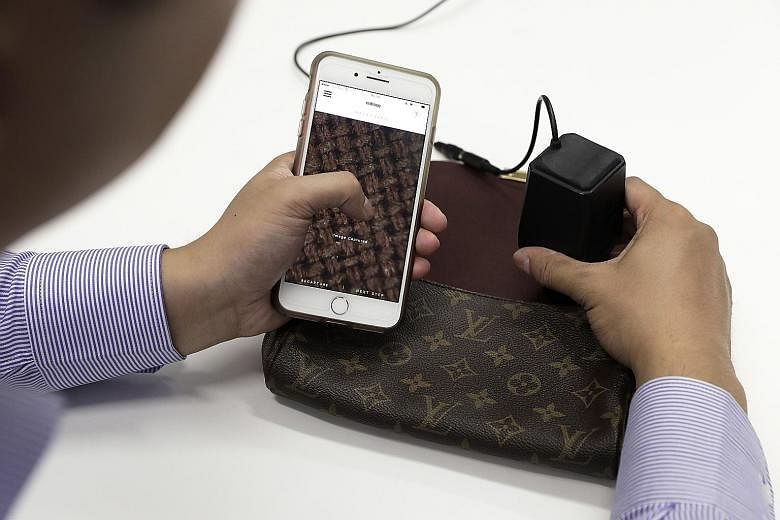NEW YORK • This is not fake news. Distinguishing an authentic Louis Vuitton bag from a well-made fake is a subtle art that involves counting stitches, feeling the leather grain and poring over print patterns.
A New York start-up says it has a technology that can spot counterfeits without the guesswork.
Entrupy's solution is a handheld microscope camera that lets anyone with a smartphone check a luxury accessory within minutes.
Since launching the service a year ago, the company says its accuracy has improved to better than 98 per cent for 11 brands, including Louis Vuitton, Chanel and Gucci.
Holographic tags, microprinting and even radio beacons woven into fabric have been used by fashion labels for years to help establish the authenticity of their products.
Apparel makers will spend US$6.15 billion (S$8.3 billion) on anti-counterfeit technologies this year, said London-based researcher Visiongain.
But the anonymity of Internet shopping and growing popularity of secondhand dealers are making the war against fakes harder.
"Even 10 years ago, a woman going to buy a secondhand bag would know very well that Chanel, Gucci and Prada don't sell on the street corner," says Ms Susan Scafidi, director of the Fashion Law Institute at Fordham University, New York.
"But now, with so much legitimate and illegitimate commerce occurring online, it is very difficult for consumers to tell the difference."
The issue was highlighted last year, when the International AntiCounterfeiting Coalition suspended the membership of China's biggest online retailer, Alibaba Group, amid criticism that it and other e-commerce marketplaces were not doing enough to cull fakes.
Alibaba founder Jack Ma did not help matters when he said Chinesemade knock-offs today can offer better quality than the genuine articles.
Secondhand online stores such as RealReal and Vestiaire Collective use experts with years of experience to determine the authenticity of the goods they buy and sell.
It is a painstaking process that is not entirely foolproof, said some online reviews from customers who complain they have been sold counterfeits.
Entrupy says its camera magnifies objects 260 times so features invisible to the human eye become telltale signs: misshapen stamp marks, tiny gaps in the leather grain and paint overruns.
The device, which looks like a bulky flashlight with a wireless connection, can be leased for an initial fee of US$299.
Monthly plans start at US$99.
So far, about 160 businesses, including pawn shops, wholesalers and online retailers, have signed up.
Entrupy's database now has tens of millions of photographs from about 30,000 handbags and wallets. The software learns as clients upload new pictures.
Entrupy in July raised US$2.6 million from investors led by a venture between Tokyo-based Digital Garage and Daiwa Securities Group.
The money will be used to design a faster and more portable camera as well as add more brands to Entrupy's list, says its co-founder Vidyuth Srinivasan.
The company is also looking at other uses for its software.
"The technology works pretty well on everything except for diamonds and porcelain because those are refractive and we use optical analysis," he noted.
"We've already tested it on auto parts, phones, chargers, headphones, jackets, shoes, even crude oil."
BLOOMBERG

